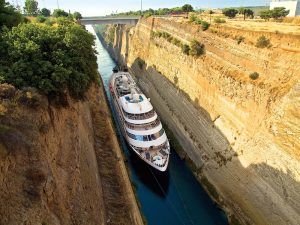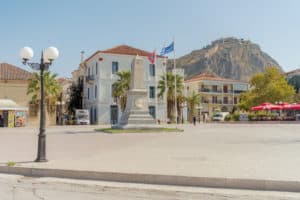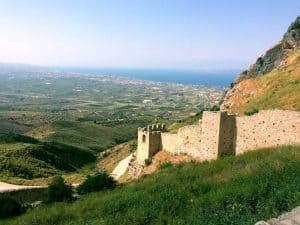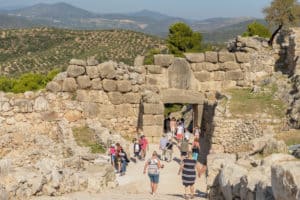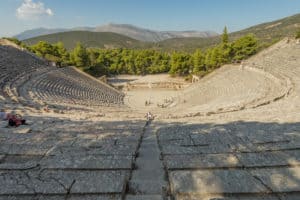Our places – PELOPONNESE GUIDE
Our guide to the Peloponnese
Historically it is one of the most important regions of Greece. It is packed with sites such as Ancient Corinth, and includes the UNESCO classified sites of Olympia, Mycenae, Mystras, Tyrins, and the Temple of Asklepeus at Epidaurus with its Unique Classical Theater.
Touring these sites with their rich associated museums is a once in lifetimes experience. Certainly, this is amplified by the many other wonderful things on offer in this region. The views along the way of its unspoiled natural environment with its rolling hills, mountains, olive & orchard fields make any trip a pleasure. There is a bounty of high-quality cuisine to enjoy and a wealth of glorious beaches to relax on with pristine clear water.
Exploring the central areas replete with pretty mountain village chains like those surrounding Mt.Kyllini is wonderful. With some of the most dramatic landscapes to be found around the pretty village of Dimitsana and the Lousios Gorge. Along the three main southerly peninsulas or ‘legs’ which extend into the Aegean, are some of the least trodden locations. Many of Greece’s most beautiful settlements can be found there. The Venetian Nafplion, Gythio, and the stunning Monemvasia for example.
Dedicate time to this region!
Invariably first-time travelers go for the UNESCO highlights. If you have been there & done that, then we recommend the rugged Mani-Peninsula with its pretty regional capital of ‘Cardomili’ & impressive Castle-like Tower houses. Alternatively, towards the Southwestern tip, the region of Pilos is equally unspoiled & has the gem of Methoni Castle nearby along with a great many smaller local sites.
From the West, the modern city of Patra is linked back to the Mainland by the large Rio-Antirio suspension bridge. Crossing over this on our multi-day tours we continue towards the olive-filled Plestos Valley & Delphi. From there returning to Athens via Meteora, Pelion, or the other highlights of the North.
What to See & Do
However, if you have a day or two extra to spare then you can combine with Ancient Olympia and its Museum of masterpieces. Just browse our Multi-Day Tours page which has many choices along with all details & direct booking.
Further south we travel to the stunning Mani Peninsula, or to the Medieval island city of Monemvasia, accessible by causeway & perfect for a getaway in one of the old captain’s houses. Whilst, for a week or more, our 7-Day Peloponnese Tour covers everything.
4 of our most popular Peloponnese-Tours are listed below, but you can see all Day-Tours, Multi-Day Tours, and Packages from our main menu.
Do
For Activity lovers, the Menalon Trail runs for many kilometers. See our dedicated page on Activity Tours. However, the local islands of Spetses and Hydra are very close to the southern shores of the Peloponnese with short ferry trips so high on our list would be a visit to one of these unspoiled Islands. Just see our related tour ‘5-Day Athens & Peloponnese Highlights with Spetses & Hydra Islands’.
All tours can be tailored so add on some more days at the perfect beach spot, or just let us know how many days you have when you arrive, & let us do the work for you with a suggested Itinerary!
Tips from the Penguin
Don’t Miss
Surprisingly, Ancient Olympia is often overlooked on schedules booked from a distance due to the extra day required. This is an extensive site with much to see & so much history to absorb. We like to combine this with a 5-star hotel nearby to make the experience outstanding. This is one tour that will not disappoint in any schedule.
History of the main sites
The Corinth Canal
The body of the Peloponnese separates the Adriatic and Aegean making the ancient trading route a 320km circumnavigation by sail ship. No insignificant distance or risk as the many shipwrecks uncovered along the tips of the Peloponnese attest.
Small wonder that a narrowing of the land at the Isthmus of Corinth to just 6km inspired the dreams of ancient Greek Kings in connecting both seas with a canal. A first such attempt was made in the 7th Century BC but which was abandoned and as an alternative, a stone causeway ‘diolkos‘ was built over which ships could be pulled from one side to the other. Amazingly, parts of this original 6000-year-old work are still visible, running parallel alongside today’s modern canal.
During the later Roman times, no less than three Roman Emperors, Julias Ceasar, Caligula, and Nero, all ordered the construction of a canal, but all died before completion. Nero even broke ground personally with a workforce of 6000 Jewish prisoners who left a monument in the channel and which also remains present today.
Despite the large manpower involved in all these early efforts, all were abandoned due to the scale, difficulty & expense of moving such vast amounts of material, and no further attempts were made in the hundreds of years that followed until the Greeks finally gained independence from the Ottoman Empire in 1830. With the momentum of a new beginning for the Greeks and with the inspiring example of the newly completed Suez Canal, renewed attempts were finally successful with completion in 1893 of today’s canal after more than 10 years of work. One that also follows Nero.s original plan.
Paradoxically, after all the centuries of endeavor, constant landslips from the week rock meant the canal spent much of its early years closed, a period which also coincided with the development of diesel-powered ships too large to fit in the narrow 6-meter channel. A strategic part of Greek infrastructure, operations were also impeded by damage during WWII with fighting between the German & Allied troops holding the bridges. All combined to make commercial shipping obsolete.
Nevertheless, today’s Corinth Canal is in daily operation and whilst not facilitating the bustling trade originally envisioned for it, nevertheless does great service to various small cruise ships & sailboats which pass in convoy from one side & then from the other. From the vantage point of several footbridges it’s still an impressive sight, and easy to visualize all those past challenges.
Nafplio
Nafplion was not an ancient city or significant settlement for the early Greeks but grew in size from the Middle ages. By 1212 it was in the hands of French crusaders, becoming part of the Byzantine empire. It was sold to Venice in 1338 and during the next 150 years expanded & flourished with some beautiful architecture that remains today in much of the old town area.
The Venetians fortified the city heavily. In 1473 Bourtzi Castle was built in the channel at the entrance of the port to protect the city from invasion & sea pirates, and the extensive Palamidi Castle with its 10 Bastions was built in just 3 years to span the hilltop above the city in 1711.
After the Venetian occupation, the city continued to change hands many times and became an important stronghold of the Ottoman Empire before its final liberation at the start of the Greek war of independence in 1821 after a year of siege. At that time it was made the Capital of Greece and its first head of state was subsequently assassinated on the steps of the church of Saint Spyridon. The bullet marks can be seen in the street. After the arrival of King Otto he decided to move the capital to Athens in 1834.
As a modern city, Nafplion is the capital of the local region of Argolis & a tourist hub in an area packed with classical and ancient sites. It retains its beautiful seaside location, Venetian Architecture & Historical landmarks. Its closeness to Athens also helps a strong local economy that has an upmarket & arty feel with lots of arts, crafts & boutique shops popular with foreign residents. Its Museums like the War Museum & Archaeological Museum are also good & will add much to your visit if you want to learn more about the history of this region.
Our visitors today can ascend the 999 steps up to Palamidi Castle, although driving up to the main gate is a more easy alternative and it’s fun to take a short water taxi trip out to Bourtzi Castle which departs regularly from the marina area just in front of the Cafes & Restaurants.
For all these reasons Nafplion is great to visit with something for everyone. Where some of the older Hotels were in need of upgrading, this situation has more recently been improved with many nice renovated buildings turned into small friendly Hotels with good service.
Ancient Corinth
Please see our Guide to Corinth Here
Ancient Mycenae
When talking about the ruins of Mycenae in the Peloponnese, we can broaden the term to the ‘Mycenian era’, a period between 1600 BC to about 1100 BC, which designates this as the first coherent & homogeneous culture to have arisen in the mainland and wider region. Although proceeded the Minoan civilization based on Crete it was much more widespread with Minoan palaces located throughout Greece with similar structures, Architecture, organization, hierarchies, artistic motifs, and developed economies along with their aggregation of the population into centers, and communal works that would have involved a large proportion of the population in concerted efforts.
The ruins of Ancient Mycenae, which date from the late Bronze age, are considered the center of the Mycenean civilization, and along with the nearby ruins at Tiryns, is listed by UNESCO as a World Heritage Site.
Its origins are unknown but in Greek Mythology the city was founded by Perseus, son of Zeus who instructed the Cyclops to build its walls with stones no human could lift. Seeing the structures remaining at the Archaeological site with stone blocks of many meters in dimension, this is certainly the first thing that jumps to mind. Similar structures made from stone at other Mycenean sites, such as the wall around the Acropolis rock in Athens, are termed ‘Cyclopedean walls‘ in reference to something that only giants could build.
Probably, Mycenae is best known as the city of Agamemnon & leader of the Greeks in their war against Troy. Homer’s Iliad described the city as ‘golden Mycenae’. Something substantiated by many gold objects totaling over 15kg which have been recovered from grave shafts at the site.
Like Corinth, Mycenae seems to have grown rich from trade, with the local workshops highly productive in luxury goods, weapons, tools, jewelry, glass ornaments, and vases, which likely transported oil, wine, and other commodities. From the 1600 BCE, there is evidence of an elite at the site with expansion of habitation, rich paintings, and construction of large ‘tholos’ tombs including the amazing Treasury of Atreus which is around 13.5 meters in height. From the 14th century BCE, a large scale palace was put in place along with other structures like large fortification walls, flood management, and roads. Early Linear B tablets, often used for accounting purposes for the distribution of resources are also found.
Mycenae and the Mycenaean civilization began to decline around 1200 B.C. The city seems to have been abandoned around 100 years after this time, but whether by natural disasters such as fire or earthquake, political turmoil, or invasion is not clear.
Visiting today, the walls of the citadel are still in place, as is the impressive 3×3-meter main entrance. This is caped with an 18 ton Lintel with two, three-meter high heraldic lions leading to its name, the ‘Lion Gate’ which then leads directly up to the ‘palace of Agamemnon’.
An obvious center of political, religious & commercial power, some of the high-value grave goods can be seen in the excellent on-site museum which also has many reconstructions of the life & times of Mycenae. The famous gold burial masks of Agamemnon can be seen at the National Archaeological Museum in Athens, but a copy is also present in the museum.
Epidaurus Theater & the Sanctuary of Asklepios
The Sanctuary of Asklepios
The sanctuary of Asklepios, the god of medicine, developed around the 6th century BC. It is considered the first center of medicine in the Ancient world & represents a transition from divine healing towards scientific medicine. As such it is also a UNESCO registered site.
The sanctuary was a major site of pilgrimage and remained in use up to the Roman crackdown on pagan worship in the 4th century AD. Water was channeled from a natural sacred spring to baths other structures on the site which also had many buildings including a Theatre, the Temples of Artemis, the Tholos, Propylaia, and Baths, as well as sport and hospital facilities.
At its epicenter was the temple dedicated to the God Asklepios. Only its foundations now remain but we know from various sources that it was a classic Doric style temple with 6 by 11 columns & 80 feet long. All Greek temples had a statue of the deity inside. Pausanias, who described the sanctuary in the 2nd century tells us that ‘The image of Asklepios is, in size, half as big as Zeus Olympios at Athens, and is made of ivory and gold’.
During antiquity, individuals with illness could seek remedy by worship and sacrificial offerings to Gods such as Apollo, Artemis, Hygieia; or they could go to a Hippocratic physician offering more practical or herbal remedies. At the Asklepion these pilgrims would undergo ceremonial bathing before sleeping in an open plan 60-bed room with snakes on its floor, an omen of rebirth, and rejuvenation. It was hoped that the God would then visit them in their sleep with the remedy and this they would relate to the priests the next day, who would in turn act upon the god’s instructions. There remain at the site many inscriptions by former patients cured in this way of a variety of ailments.
Gradually, the Asclepieia began employing & focusing on scientific remedies, and therefore at these centers, there was a combined spiritual and scientific approach serving the wide population with parallels found in modern approaches to holistic medicine. As the influence of the Sanctuary developed, many Greek cities of antiquity such as Kos, Athens & Corinth developed an Asclpion such that these can be thought of as the first local clinics of hospitals to have existed.
The Great Theatre of Epidaurus
Like many centers of pilgrimage & worship in the ancient world, these local centers became wealthy from the offerings of their visitors and this wealth was often channeled into public works. The Theatre of Epidaurus, built in the 4th Century BC, was dedicated to the God Asklepios and is considered both aesthetically and acoustically to be the most perfect ancient Greek theatre.
Today it is one of the most visited attractions in Greece and also continues as a working theatre with a festival of plays every summer. With a large 14000 capacity, the whispers of modern performers may be heard even in the top tiers of seating and many visitors come to recite poems or sing arias in its center circle.

